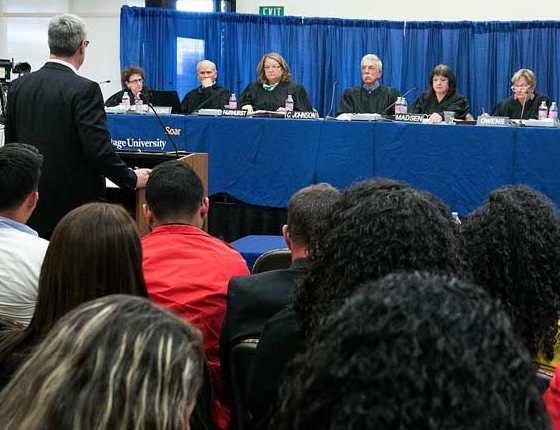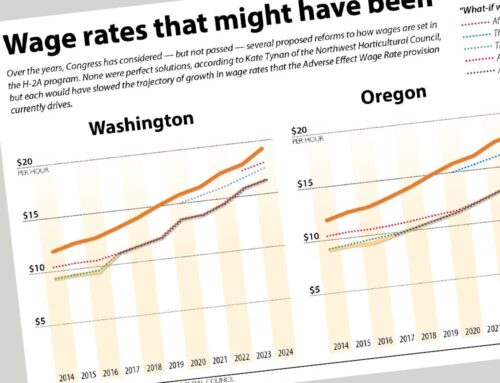
The Washington State Supreme Court listens to attorney Adam Belzberg, left, talk on behalf of Sakuma Bros. Farms’ position about piece rate rest breaks during a public hearing at Heritage University in Toppenish, Washington, on March 17, 2015.(TJ Mullinax/Good Fruit Grower)
It could be months before the Washington Supreme Court issues a ruling on whether or not farm workers who are paid piece rate need to be paid extra for rest breaks. In the meantime, what should growers do?
“One option is to do nothing and cross your fingers,” said Brendan Monahan, attorney with Stokes Lawrence in Yakima, Washington. “But doing nothing is not a good option.”
He suggested that, at minimum, every employer should look at their employee handbook and make sure it is clear that the piece rate compensates workers for everything they do during the working day—not just picking fruit or pruning trees, but moving ladders, moving between tasks, and taking breaks, for example.
All employees should be made aware of this when they are recruited, even though the employer might have a large number of workers coming and going during harvest, Monahan stressed. They need to sign that they have received the piece-rate policy, along with other policies, and they need to be told orally in English and Spanish.
Extra pay
Monahan said growers could start paying piece-rate workers an additional $3.16 per day, representing 20 minutes at Washington’s minimum wage of $9.47 per hour, which would still be less than the plaintiffs in the case are seeking. Whether this makes sense depends on their risk tolerance, bearing in mind that court damages could go back three years.
“It’s not realistic to jump in line and do everything they want, but your goal as an employer is to get to the back of the line of people they’re going to sue,” he said. “They can’t sue everybody at once. The people they’re going to sue are the people who don’t have policies that explain about what the piece rate covers.”
Adam Belzberg, partner with the law firm Stoel Rives, said growers should realize, however, that if they do pay the extra $3.16 per day it would be difficult to take it away without affecting worker morale. “Once you do it, you’re locked in,” he warned.
Belzberg said it’s also advisable for employers to enforce rest breaks. Though the regulations say that an employer “shall allow” rest breaks, a Court of Appeals ruled, in a non-agricultural case, that it means that employees must be given breaks.
“I’ve been encouraging my grower clients to absolutely enforce breaks,” he said. “It’s a tough thing to do, but making sure you document that everyone has had a 10-minute break is important.”
Monahan said there’s a risk that if you require piece-rate workers to take a break, they’ll just go work for your neighbor who doesn’t enforce breaks because the workers feel that every minute they’re not working they’re losing money.
“It’s going to be a tough educational transition for the industry,” he said. “But it has to happen.”
Bonus
Dan Fazio, director of the Washington Farm Labor Association, now known simply as WAFLA, said another option is for growers to pay a combination of an hourly rate plus bonus.
So, for example, if the minimum wage was $10, growers could pay an apple picker $10 an hour for eight hours’ work ($80), which would include rest breaks. A bonus of $20 a bin would kick in after the worker had picked four bins. Assuming the worker picks eight bins, the pay for the day would be the same as a piece rate of $20 a bin, but rest breaks would be clearly covered.
Monahan said it would take time for workers to get used to such arrangements. “If you get workers showing up at the ranch and you say, ‘We’re paying you piece rate, but the piece rate for the first four bins is zero,’ they’re going to turn around and go work for your neighbor.”
Employers who hire H-2A workers would not be able to adopt this approach because they are required to pay workers according to prevailing practices, Fazio said. •






Leave A Comment